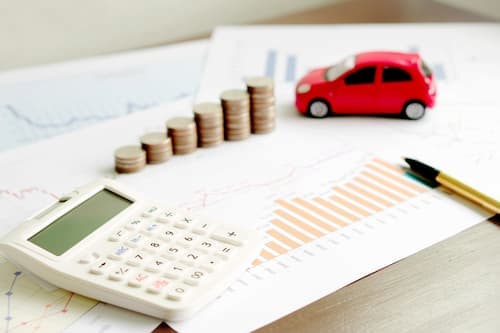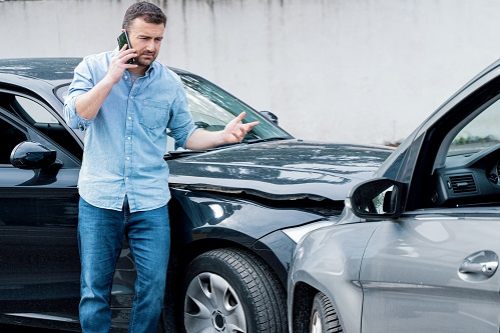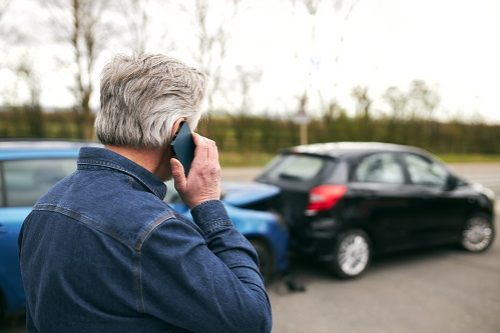- How much does car insurance increase after an accident?
- How long does an accident affect your insurance?
- How much does insurance increase after an accident by company?
- How much does insurance increase after a minor accident?
- How much will insurance go up after a totaled car claim?
- How to avoid an insurance increase after an accident
- Methodology
- FAQ: Insurance after an accident
How much does car insurance increase after an accident?
Car insurance increases by an average of $1,067 a year nationwide, based on a full coverage policy with 100/300/100 liability limits ($100,000 per person and $300,000 per accident for bodily injury, $100,000 per accident for property damage) and $500 deductibles.
The following five states top the list for the most expensive average full coverage rates following an accident claim. Louisiana tops the list.
| State | Average rate with a clean record | Rate after an accident | $ difference | % difference |
|---|---|---|---|---|
| Louisiana | $2,883 | $4,279 | $1,396 | 48% |
| California | $2,416 | $4,244 | $1,828 | 76% |
| Florida | $2,694 | $3,952 | $1,258 | 47% |
| Michigan | $2,352 | $3,673 | $1,321 | 56% |
| Kentucky | $2,228 | $3,597 | $1,369 | 61% |
These are the five states with the lowest average rates after an accident. Maine has the cheapest rates.
| State | Average rate | Rate after an accident | $ difference | % difference |
|---|---|---|---|---|
| Maine | $1,175 | $1,732 | $557 | 47% |
| Vermont | $1,319 | $1,866 | $547 | 41% |
| New Hampshire | $1,265 | $1,886 | $621 | 49% |
| Hawaii | $1,517 | $2,116 | $599 | 39% |
| Idaho | $1,428 | $2,214 | $786 | 55% |
The table below shows the average amount drivers in each state pay after an accident claim. Search for your state to see the average increase.
| State | Average rate with a clean record | Rate after an accident | $ Difference | % Difference |
|---|---|---|---|---|
| Alaska | $1,676 | $2,353 | $677 | 40% |
| Alabama | $1,860 | $2,880 | $1,020 | 55% |
| Arkansas | $1,957 | $3,024 | $1,067 | 55% |
| Arizona | $1,812 | $2,814 | $1,002 | 55% |
| California | $2,416 | $4,244 | $1,828 | 76% |
| Colorado | $2,337 | $3,458 | $1,121 | 48% |
| Connecticut | $1,725 | $2,749 | $1,024 | 59% |
| Washington, D.C. | $2,157 | $3,085 | $928 | 43% |
| Delaware | $2,063 | $3,072 | $1,009 | 49% |
| Florida | $2,694 | $3,952 | $1,258 | 47% |
| Georgia | $1,970 | $3,049 | $1,079 | 55% |
| Hawaii | $1,517 | $2,116 | $599 | 39% |
| Iowa | $1,630 | $2,366 | $736 | 45% |
| Idaho | $1,428 | $2,214 | $786 | 55% |
| Illinois | $1,532 | $2,354 | $822 | 54% |
| Indiana | $1,515 | $2,508 | $993 | 66% |
| Kansas | $1,900 | $2,982 | $1,082 | 57% |
| Kentucky | $2,228 | $3,597 | $1,369 | 61% |
| Louisiana | $2,883 | $4,279 | $1,396 | 48% |
| Massachusetts | $1,726 | $2,678 | $952 | 55% |
| Maryland | $1,746 | $2,791 | $1,045 | 60% |
| Maine | $1,175 | $1,732 | $557 | 47% |
| Michigan | $2,352 | $3,673 | $1,321 | 56% |
| Minnesota | $1,911 | $2,931 | $1,020 | 53% |
| Missouri | $1,982 | $2,887 | $905 | 46% |
| Mississippi | $2,008 | $3,430 | $1,422 | 71% |
| Montana | $2,193 | $3,085 | $892 | 41% |
| North Carolina | $1,741 | $2,932 | $1,191 | 68% |
| North Dakota | $1,665 | $2,272 | $607 | 36% |
| Nebraska | $1,902 | $3,099 | $1,197 | 63% |
| New Hampshire | $1,265 | $1,886 | $621 | 49% |
| New Jersey | $1,902 | $3,442 | $1,540 | 81% |
| New Mexico | $2,049 | $2,950 | $901 | 44% |
| Nevada | $2,060 | $3,245 | $1,185 | 58% |
| New York | $1,870 | $2,393 | $523 | 28% |
| Ohio | $1,417 | $2,385 | $968 | 68% |
| Oklahoma | $2,138 | $3,170 | $1,032 | 48% |
| Oregon | $1,678 | $2,670 | $992 | 59% |
| Pennsylvania | $1,872 | $2,862 | $990 | 53% |
| Rhode Island | $2,061 | $2,376 | $315 | 15% |
| South Carolina | $2,009 | $2,890 | $881 | 44% |
| South Dakota | $2,280 | $3,189 | $909 | 40% |
| Tennessee | $1,677 | $2,623 | $946 | 56% |
| Texas | $2,043 | $3,475 | $1,432 | 70% |
| Utah | $1,825 | $2,891 | $1,066 | 58% |
| Virginia | $1,469 | $2,309 | $840 | 57% |
| Vermont | $1,319 | $1,866 | $547 | 41% |
| Washington | $1,608 | $2,475 | $867 | 54% |
| Wisconsin | $1,664 | $2,535 | $871 | 52% |
| West Virginia | $2,005 | $2,978 | $973 | 49% |
| Wyoming | $1,758 | $2,454 | $696 | 40% |
Car insurance rates after multiple accidents
If you have a second accident while the previous accident is still affecting your insurance rates (usually within three years), your rates will increase even more. The average cost of insurance nationwide with two at-fault accidents is $4,217, an increase of 122% from a clean record. Here’s a look at how insurance rates increase with multiple accidents in each state.
| State | Average rate with a clean record | Average rate after multiple accidents | % Difference |
|---|---|---|---|
| Alaska | $1,676 | $3,110 | 86% |
| Alabama | $1,860 | $3,932 | 111% |
| Arkansas | $1,957 | $4,121 | 111% |
| Arizona | $1,812 | $3,778 | 108% |
| California | $2,416 | $6,335 | 162% |
| Colorado | $2,337 | $4,608 | 97% |
| Connecticut | $1,725 | $5,130 | 197% |
| Washington, D.C. | $2,157 | $4,034 | 87% |
| Delaware | $2,063 | $4,424 | 114% |
| Florida | $2,694 | $5,047 | 87% |
| Georgia | $1,970 | $4,236 | 115% |
| Hawaii | $1,517 | $2,603 | 72% |
| Iowa | $1,630 | $3,083 | 89% |
| Idaho | $1,428 | $3,019 | 111% |
| Illinois | $1,532 | $3,354 | 119% |
| Indiana | $1,515 | $3,873 | 156% |
| Kansas | $1,900 | $4,013 | 111% |
| Kentucky | $2,228 | $4,774 | 114% |
| Louisiana | $2,883 | $6,082 | 111% |
| Massachusetts | $1,726 | $3,969 | 130% |
| Maryland | $1,746 | $3,716 | 113% |
| Maine | $1,175 | $2,589 | 120% |
| Michigan | $2,352 | $6,621 | 182% |
| Minnesota | $1,911 | $4,234 | 122% |
| Missouri | $1,982 | $3,729 | 88% |
| Mississippi | $2,008 | $4,730 | 136% |
| Montana | $2,193 | $3,837 | 75% |
| North Carolina | $1,741 | $3,528 | 103% |
| North Dakota | $1,665 | $3,048 | 83% |
| Nebraska | $1,902 | $4,405 | 132% |
| New Hampshire | $1,265 | $2,586 | 104% |
| New Jersey | $1,902 | $5,427 | 185% |
| New Mexico | $2,049 | $3,826 | 87% |
| Nevada | $2,060 | $4,442 | 116% |
| New York | $1,870 | $3,337 | 78% |
| Ohio | $1,417 | $3,563 | 151% |
| Oklahoma | $2,138 | $4,061 | 90% |
| Oregon | $1,678 | $3,596 | 114% |
| Pennsylvania | $1,872 | $4,031 | 115% |
| Rhode Island | $2,061 | $2,149 | 4% |
| South Carolina | $2,009 | $3,731 | 86% |
| South Dakota | $2,280 | $4,158 | 82% |
| Tennessee | $1,677 | $3,550 | 112% |
| Texas | $2,043 | $4,938 | 142% |
| Utah | $1,825 | $4,376 | 140% |
| Virginia | $1,469 | $3,232 | 120% |
| Vermont | $1,319 | $2,756 | 109% |
| Washington | $1,608 | $3,944 | 145% |
| Wisconsin | $1,664 | $3,592 | 116% |
| West Virginia | $2,005 | $4,129 | 106% |
| Wyoming | $1,758 | $3,221 | 83% |
How long does an accident affect your insurance?
The average length of time is three years, but it may be as long as five years. The time period varies by state. This time period doesn’t start when the accident happens, but when the insurance company first adds it to your policy. That means that it will start at your first renewal after the accident and continue until the three to five years are over.
How much does insurance increase after an accident by company?
The cheapest car insurance company before you have an accident may not be the cheapest after you file a claim.
USAA has the cheapest average rates both before and after an accident but is only available to military families. Prior to an accident, Nationwide’s rates are the cheapest, but State Farm is the cheapest after an accident due to an average increase of only 23%. GEICO has the largest average increase at 82%.
| Company | Average premium with a clean record | Average premium with one at-fault accident | % difference |
|---|---|---|---|
| USAA* | $1,381 | $2,091 | 51% |
| State Farm | $1,984 | $2,438 | 23% |
| Travelers | $1,606 | $2,509 | 56% |
| Nationwide | $1,548 | $2,564 | 66% |
| Progressive | $1,998 | $3,116 | 56% |
| GEICO | $1,763 | $3,207 | 82% |
| Farmers | $2,387 | $3,992 | 67% |
| Allstate | $2,509 | $4,149 | 65% |
*USAA is only available to military members, veterans and their families
How much does insurance increase after a minor accident?
The severity of the accident doesn’t have as much of an impact on the rate increase as you would think. As far as the insurance company is concerned, an accident is an accident. If you are at fault, you will be surcharged regardless of how minor or serious the accident was. However, a very minor accident or a very serious one may have different effects on rates in some cases.
How much will insurance go up after a totaled car claim?
The fact that the car was totaled doesn’t usually impact the rate increase after an accident. Some companies may charge more after a serious accident than they do after a minor one, but the threshold for an accident being considered minor is usually low, around $2,000. The amount of the claim is more likely to affect the payout.
In some cases, the insurance company may pay out more in an accident where the car wasn’t totaled. The amount it takes to total an older vehicle, for example, could be the same as the cost of moderate repairs to a new, high-end vehicle.
How to avoid an insurance increase after an accident
There are a few ways you might avoid an insurance rate increase after an accident. The first is to have accident forgiveness. The caveat here is that you must add it to your policy before the accident happens. There may be an added charge for this coverage; some companies offer it for free to policyholders who have had a clean record for a certain period, usually three to five years.
Accident forgiveness doesn’t apply to all accidents; it usually only applies to minor accidents and generally only applies to the first accident.
Without accident forgiveness, you might be able to avoid a rate increase by handling any repairs yourself and not filing a claim. This will again only work in a minor accident and only if the other driver agrees. If there are any injuries, it’s best to file a claim.
Methodology
Insurance.com commissioned Quadrant Information Services to field rates in late 2023 for a full coverage car insurance policy with limits of 100/300/100 and $500 deductibles with a clean record, one accident and two accidents. Driver profile is a 40-year-old male driving a 2023 Honda Accord LX with good credit and no traffic violations.
FAQ: Insurance after an accident
Do insurance rates go up after a no-fault accident?
In a no-fault state, your car insurance company will pay for your injuries regardless of who is at fault in the accident. Personal injury protectionPersonal injury protection (PIP) pays for your medical, hospital and funeral expenses resulting from a car accident, regardless of who's at fault. (PIP) coverage is designed for this purpose.
However, even in a no-fault state, where fault doesn’t decide which insurance company pays the injury claim, one driver will still be found at fault for the accident. If you are found at fault, you will likely see a rate increase.
How much does insurance go up after an accident for a teenager?
Since teenagers already pay very high rates, you can expect the rate increase after an accident to be higher than for an older driver with a longer driving record. The increase will depend on the teen’s previous record, their age, where they live and other factors.
Does a car accident affect your credit score?
No. The only way a car accident could affect your credit is if there is a legal judgment against you in court or other bills related to the accident that you fail to pay.
Does a single-car accident raise your insurance?
Even if no other vehicles are involved, a car accident claim will likely raise your rates. However, if you have a minor accident with no other cars involved and no damage or injuries to others, you may be able to avoid a rate increase by repairing your vehicle out of pocket.



